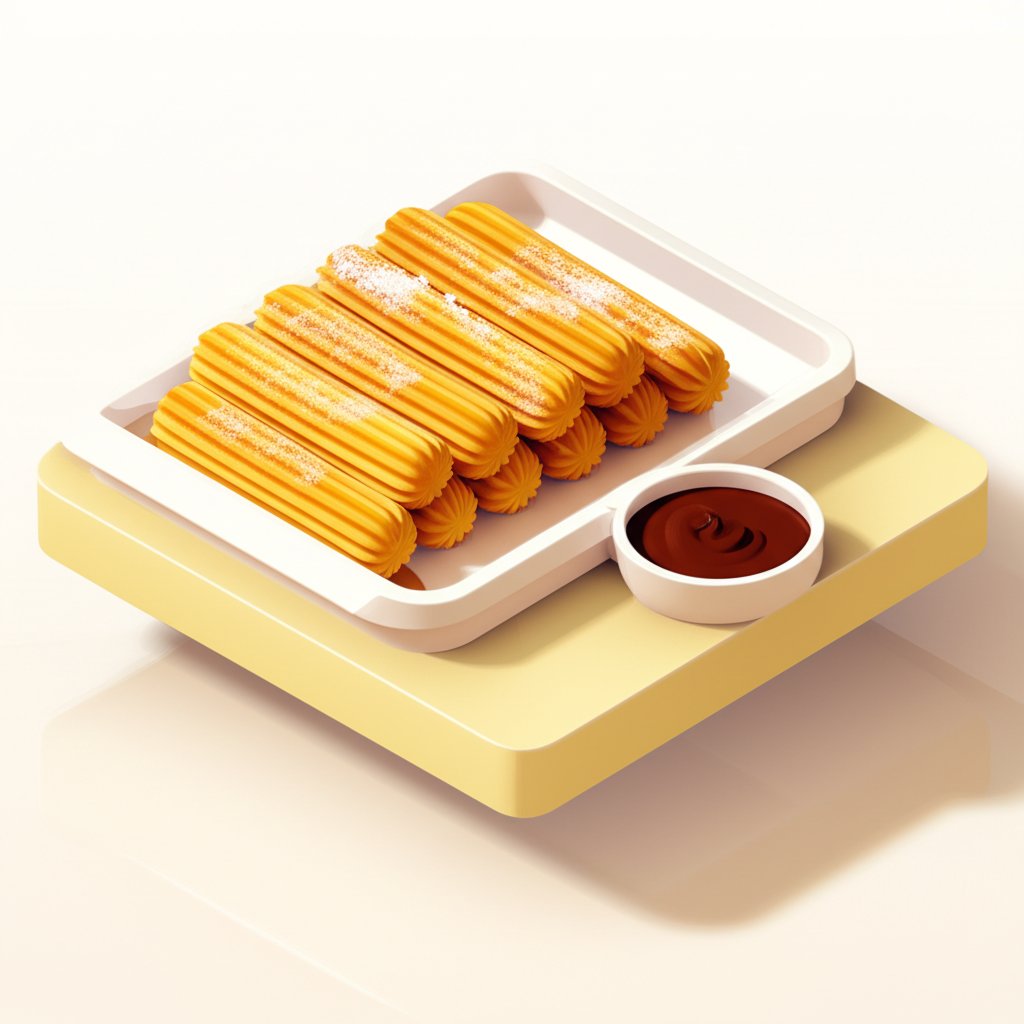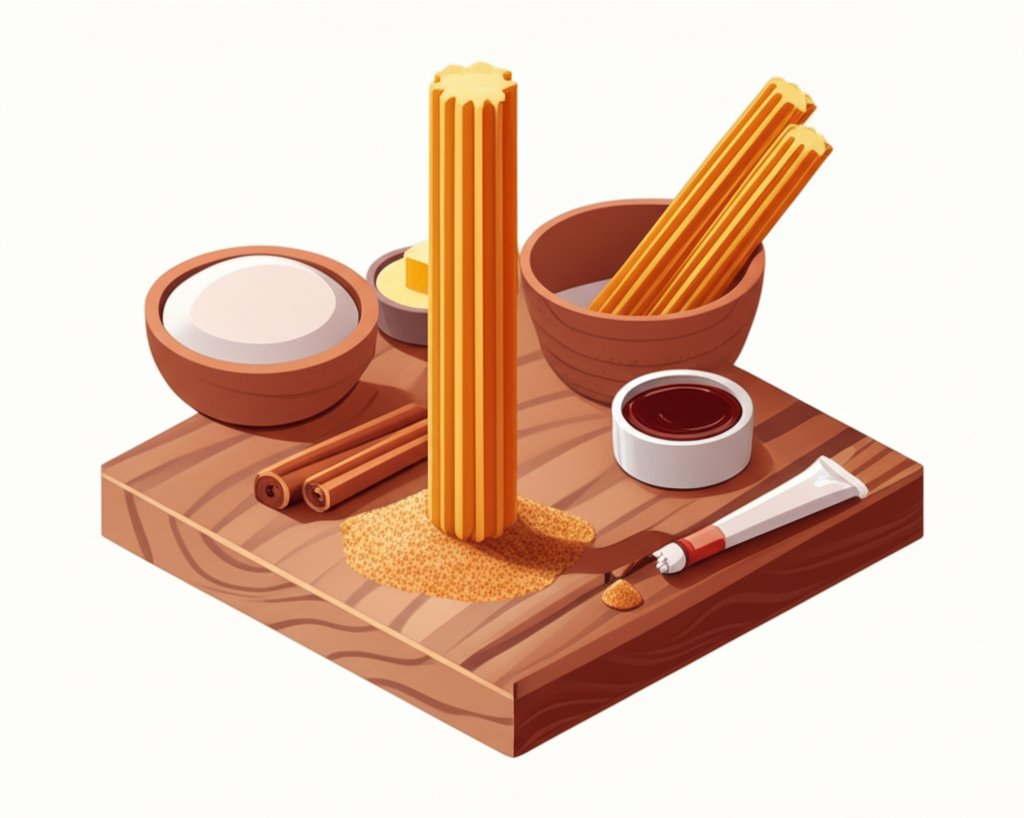Step into a world where golden, crispy, cinnamon-sugar delights tell a tale of ancient origins, culinary innovation, and heartwarming tradition. Welcome to the ultimate guide to Mexican churros, a beloved treat that has captivated palates across the globe. Far more than just a sweet snack, churros embody a rich tapestry of facts about churros, history, and cultural significance, especially vibrant in Mexico.
In this comprehensive exploration, we’ll unravel the intriguing journey of these fried dough wonders, from their disputed beginnings to their iconic status as a quintessential Mexican doughnut. Get ready to dive deep into what makes churros in Mexico uniquely irresistible, distinguish them from other “Mexican doughnuts,” and discover the fascinating stories and preparations behind every delicious bite. Prepare to satisfy your curiosity and ignite your cravings!
Delving into the debated origins, it’s fascinating to consider the real churro recipe history and how these delectable treats evolved into the beloved form we know today.
The Enigmatic Origins of Churros: A Global Journey
The story of the churro is as rich and complex as its flavor profile, shrouded in theories that span continents and centuries. Pinpointing the exact birthplace of this iconic treat is a delightful puzzle, but its evolution showcases a remarkable journey across cultures.
Shepherd’s Delight or Portuguese Passage?
One popular theory suggests that churros originated with Spanish shepherds. Living in remote mountains with limited access to bakeries, these ingenious herders supposedly created a simple dough that could be easily fried over an open fire. The resulting pastry, crisp on the outside and soft within, provided a much-needed energy boost. They named it after the horns of the “Churra” sheep, which they tended, due to its distinctive ridged shape.
However, another compelling theory traces the churro’s lineage back to China. It’s believed that Portuguese navigators, returning from the Far East, brought back the recipe for a similar fried dough pastry known as “YouTiao.” This savory, unsweetened fried bread was adapted by the Iberian Peninsula, where it was transformed into a sweet treat, eventually making its way to Spain. Regardless of the precise origin, what’s clear is that the basic concept of fried dough has a long and varied history across many cultures, with Spain playing a pivotal role in shaping what we recognize as the churro today.
Bridging Continents: Churros Arrive in the New World
From Spain, the churros embarked on their most significant journey: across the Atlantic to Latin America during the 16th century. Spanish conquistadors and settlers introduced their culinary traditions, including this versatile fried dough, to the New World. In countries like Mexico, Argentina, Colombia, and Peru, churros were embraced wholeheartedly and began to evolve, absorbing local flavors and customs.
This migration was a turning point, laying the groundwork for the diverse array of churros we see today. Each region added its unique touch, but it was in Mexico where the churro truly blossomed into an art form, adopting a distinctive character that sets it apart from its Spanish ancestors.
What Makes Mexican Churros Uniquely Irresistible?
While the concept of fried dough sticks in cinnamon sugar might seem universal, Mexican churros boast a distinct identity that makes them a beloved and unique culinary experience. The magic lies in specific ingredients, preparation, and presentation.
The Signature Mexican Flavor Profile
The most notable characteristic of a Mexican churro is its generous coating. Unlike their Spanish counterparts, which are often simply dusted with sugar, churros in Mexico are typically rolled in a delightful, aromatic mixture of cinnamon and granulated sugar. This sweet and spicy crust creates an immediate burst of flavor and a satisfying texture contrast with the warm, airy interior. This cinnamon-sugar embrace is arguably the defining feature that differentiates Mexican churros and contributes significantly to their widespread appeal. It elevates the simple fried dough into a sensory experience that tantalizes both the nose and the palate.
Fillings and Forms: A Symphony of Sweetness
Another hallmark of the Mexican churro is its versatility, particularly when it comes to fillings. While Spanish churros are usually hollow and served with a dipping sauce, Mexican churros frequently come filled with a variety of delectable sweet treats. Popular fillings include:
- Cajeta: A rich, caramelized goat’s milk confection, similar to dulce de leche but with a distinct, deeper flavor.
- Dulce de Leche: A creamy, sweet caramel made from cow’s milk.
- Chocolate: Often a rich, dark, and slightly bitter chocolate sauce that perfectly balances the sweetness of the churro.
- Guava or Fruit Preserves: Lighter, fruitier options that offer a different kind of sweetness.
These fillings are typically injected into the churro after frying, creating an explosion of flavor and a moist center that complements the crispy exterior. The churros themselves also vary in size and thickness, from long, thin sticks (churros finos) to thicker, more substantial ropes (churros gruesos), sometimes even coiled into spirals.
The Essential Accompaniments
No discussion of Mexican churros is complete without mentioning their perfect partners. The traditional pairing is a mug of thick, rich Mexican hot chocolate. This isn’t your average watery cocoa; Mexican hot chocolate is intensely flavored, often spiced with cinnamon and sometimes a hint of chili, and has a velvety consistency that makes it ideal for dipping. The contrast of the warm, crisp churro with the decadent, melted chocolate is pure bliss.
Beyond hot chocolate, churros in Mexico are also frequently enjoyed with a cup of strong coffee, or café de olla (a traditional Mexican coffee brewed with cinnamon and piloncillo – unrefined whole cane sugar), or even atole (a warm, thick beverage made from corn masa, often flavored with vanilla, cinnamon, or fruit). These beverages transform the churro from a simple treat into a comforting, communal experience.
Churros in Mexico: More Than Just a Snack

In Mexico, churros transcend the realm of mere dessert; they are a cultural institution, woven into the fabric of daily life and special occasions alike. Their presence signifies comfort, celebration, and tradition.
A Culinary Staple: From Street Carts to Celebrations
You’ll find churros in Mexico everywhere. From bustling street carts, where vendors fry them fresh to order, to elegant churrerías and charming cafes, they are an accessible and beloved treat. They are often enjoyed as a quick, energizing breakfast or a late-night supper, particularly after a night out. The aroma of freshly fried dough and cinnamon sugar is an inviting scent that permeates Mexican cities and towns.
During festivals, holidays, and family gatherings, churros take on an even greater significance. They are a staple at ferias (fairs), fiestas (parties), and traditional markets, adding to the festive atmosphere. Their shared enjoyment brings people together, fostering a sense of community and warmth.
Iconic Churrerías: Temples of Fried Dough
Some establishments have become legendary for their churros in Mexico. Iconic churrerías, often family-run for generations, serve as living museums of this culinary tradition. These places are not just restaurants; they are social hubs where people gather to savor a bit of history alongside their fried treats. They specialize in the art of churro making, often using secret recipes and traditional techniques passed down through time. Visiting such a place is an immersive cultural experience, offering a glimpse into the heart of Mexican culinary heritage.
Regional Variations and Local Lore
While the fundamental concept of Mexican churros remains consistent, regional nuances exist. In some areas, you might find churros made with slightly different flours, fried in specific oils, or paired with unique local dips. For instance, in coastal regions, there might be variations with tropical fruit fillings. These subtle differences reflect the rich culinary diversity of Mexico, where each state and city often boasts its own adaptation of popular dishes, adding another layer to the facts about churros narrative.
Churros vs. Other Mexican Doughnuts: A Sweet Distinction
The term “Mexican doughnuts” can encompass a variety of fried dough pastries, and while churros certainly fit the bill, it’s important to understand how they differ from other popular Mexican sweets like donas and buñuelos. Each has its own unique character, preparation, and cultural significance.
Beyond Churros: Exploring Donas and Buñuelos
- Donas: These are the most direct Mexican equivalent to the classic American-style doughnut. Donas are typically made from a yeasted dough, which is proofed (allowed to rise), then cut into rings or filled rounds, and deep-fried. They often have a fluffy, airy texture and are commonly glazed with sugar, chocolate, or sprinkled with cinnamon sugar. You’ll find donas in bakeries and cafes, often enjoyed for breakfast or as a sweet treat. They come in both “cake” and “yeast” styles, much like their global counterparts.
- Buñuelos: These are perhaps the oldest and most traditional form of “Mexican doughnuts.” Buñuelos are thin, crispy fritters, often made from a simple flour-based batter that is fried until golden and fragile. They come in various shapes; some are flat and disc-like, others are intricate rosettes, and some are simple irregular shapes. The most common varieties are either coated in cinnamon sugar or drenched in a sweet syrup (often made from piloncillo and cinnamon). Buñuelos are especially popular during holiday seasons, particularly Christmas, where families gather to make them.
Textural and Flavorful Contrasts
The key differences between these “Mexican doughnuts” lie in their preparation and resulting texture:
- Churros: Characterized by their distinct ridged shape (achieved with a star-shaped nozzle), a dense yet tender interior, and a crispy, cinnamon-sugar exterior. Can be filled.
- Donas: Generally soft, fluffy, and cake-like or airy and chewy (depending on yeast or cake base), often round with a hole or filled. Their toppings are usually glazes or simple dustings.
- Buñuelos: Very thin, extremely crispy, almost shatteringly delicate. They have a distinct crunch and a lighter, more ethereal feel compared to the dense chewiness of a churro or the softness of a dona.
Understanding these distinctions helps appreciate the unique place each of these delicious fried dough treats holds in Mexican cuisine, with churros standing out for their iconic shape, cinnamon-sugar coating, and versatile fillings.
Mastering the Perfect Mexican Churro: Techniques & Tips

While enjoying churros in Mexico from an expert churrero is an unparalleled experience, making them at home can be a rewarding culinary adventure. The appeal of Mexican churros lies in their fresh, hot state, making home preparation all the more enticing.
The Art of Churro Dough: Simple Ingredients, Precise Execution
The foundation of any great churro is its dough. Surprisingly simple, traditional churro dough typically consists of just water, flour, and salt. However, many Mexican churro recipes often incorporate a touch of butter (or oil) and sometimes an egg, which contributes to a richer flavor and a slightly more tender, less hollow interior.
- Boiling Phase: The process begins by bringing water, butter, and salt to a boil. This hot liquid is then removed from the heat, and flour is vigorously stirred in all at once. The mixture quickly comes together to form a thick, stiff dough. This cooking process, similar to pâte à choux, gelatinizes the starches in the flour, resulting in a distinct texture.
- Cooling and Mixing: After the initial mixing, the dough needs to cool slightly. If an egg is used, it’s then beaten into the warm (but not hot) dough, adding richness and helping with emulsion. The dough should be smooth, thick, and pipeable, but firm enough to hold its shape.
Frying to Golden Perfection
The frying process is crucial for achieving the signature crispy exterior and cooked interior.
- Temperature Control: Maintain a consistent oil temperature, ideally between 350-375°F (175-190°C). Too low, and the churros will absorb too much oil and become greasy; too high, and they’ll brown too quickly on the outside, leaving the inside raw.
- Star Nozzle Essential: The characteristic ridges of churros are created by extruding the dough through a pastry bag fitted with a large star-shaped nozzle (often a closed star tip). These ridges aren’t just for aesthetics; they increase the surface area, allowing the churro to cook more evenly, become extra crispy, and hold more of that delicious cinnamon-sugar coating.
- Frying Technique: Pipe lengths of dough directly into the hot oil, carefully cutting them with kitchen shears. Fry in batches to avoid overcrowding the pan, which can drop the oil temperature. Turn them occasionally until they are uniformly golden brown and crisp.
The Cinnamon-Sugar Finish: A Sweet Embrace
Immediately after frying, while still piping hot, the churros are transferred to a shallow dish containing a generous mix of granulated sugar and ground cinnamon. The heat and residual oil help the cinnamon-sugar adhere, creating that irresistible crust that defines Mexican churros. Don’t skimp on this step – it’s where much of the magic happens! Serve them warm, ideally with hot chocolate or your favorite dipping sauce.
Beyond the Bite: Intriguing Facts and Global Impact of Churros
The journey of churros extends far beyond Mexico, solidifying their status as a global culinary phenomenon. Exploring these broader facts about churros reveals their versatility and enduring appeal.
Global Adaptations and Innovations
The popularity of churros has inspired countless adaptations around the world. In the Philippines, for instance, they are sometimes served with tsokolate eh, a rich local hot chocolate. In Cuba, churros are often filled with guava paste.
Beyond traditional preparations, churro-inspired desserts and beverages have become incredibly popular:
- Churro Ice Cream Sandwiches: Imagine a scoop of rich ice cream sandwiched between two crispy churro spirals or discs.
- Churro Lattes and Milkshakes: Coffee shops and dessert parlors have embraced the churro’s flavor profile, infusing it into drinks with notes of cinnamon, caramel, and a hint of fried dough.
- Churro-flavored Cereals and Snacks: The cinnamon-sugar flavor is so iconic that it has been replicated in various packaged snacks.
These creative adaptations highlight the universal appeal and versatility of the churro’s core flavors and textures.
Churros at Festivals and Fairs
Globally, churros are synonymous with celebration. They are a beloved treat at carnivals, fairs, amusement parks, and local festivals. Their portability, deliciousness, and universal appeal make them a perfect snack for enjoying while strolling through bustling event grounds. This festive association only adds to their joyful image and reinforces their role as a treat that brings smiles. The mention of churros at Disneyland, for example, underscores their status as a universally loved indulgence that transcends cultural boundaries, even if they started far from a theme park.
Fun Churro Trivia
Here are even more fascinating facts about churros that might surprise you:
- The Longest Churro: One record-breaking churro, created in Spain, reportedly measured over 1,500 feet long, requiring a custom frying setup!
- Churro Varieties Worldwide: Beyond Spain and Mexico, you’ll find diverse churro styles. In Uruguay, they might be filled with cheese. In parts of South America, churros can be more savory, while in others, they are typically filled with dulce de leche.
- Churro for Breakfast: While often seen as a dessert, in many countries, including Spain and Mexico, churros are a very common breakfast item, particularly when dipped in coffee or hot chocolate.
These tidbits illustrate the rich global tapestry that churros have woven, evolving and adapting while retaining their fundamental, irresistible charm.
Conclusion
From their mysterious origins potentially spanning Spanish shepherds and Chinese fried dough to their undisputed reign as a quintessential Mexican doughnut, churros offer a delightful journey through history and flavor. We’ve explored the unique characteristics that define Mexican churros, from their signature cinnamon-sugar coating and varied fillings to their cherished place in cultural traditions and festive celebrations. We’ve also seen how they stand apart from other “Mexican doughnuts” like donas and buñuelos, each offering a distinct texture and taste.
The facts about churros reveal a treat that is both simple in its core ingredients and profoundly rich in its cultural impact and global appeal. Whether enjoyed fresh off a Mexican street cart, meticulously prepared in a historic churrería, or attempted with love in your own kitchen, the churros in Mexico experience is a testament to the power of food to connect us to history, tradition, and pure, unadulterated bliss. So, the next time you encounter these golden, ridged delights, remember the incredible story each bite tells, and savor the sweet, crispy magic that is the Mexican churro.
FAQ
Q: What is the main difference between Spanish and Mexican churros?
A: The primary difference is the coating and fillings. Mexican churros are almost always coated generously in cinnamon sugar and frequently filled with cajeta, dulce de leche, or chocolate. Spanish churros are typically just dusted with sugar and are usually hollow, served with a thick chocolate dipping sauce on the side.
Q: Are churros considered “Mexican doughnuts”?
A: Yes, churros are often referred to as a type of “Mexican doughnut” due to their fried dough nature and popularity in Mexico. However, it’s worth noting that Mexico also has other distinct fried dough pastries like donas (similar to traditional glazed doughnuts) and buñuelos (thin, crispy fritters).
Q: What are typical fillings for Mexican churros?
A: Popular fillings for Mexican churros include cajeta (caramelized goat’s milk), dulce de leche (caramelized cow’s milk), chocolate, and various fruit preserves like guava. These fillings are usually injected into the churro after frying.
Q: When are churros in Mexico usually eaten?
A: Churros in Mexico are enjoyed throughout the day, whether as a quick breakfast, a mid-day snack, or a late-night treat after dinner or a night out. They are also a popular item at festivals, fairs, and family gatherings.
Q: What is the origin of churros?
A: The exact origin of churros is debated. One theory suggests they were invented by Spanish shepherds. Another theory posits that Portuguese traders brought a similar fried dough pastry from China, which was then adapted in Spain. Regardless, they gained popularity in Spain before being brought to Latin America during the 16th century.
Q: How important is the star nozzle in making churros?
A: The star-shaped nozzle is crucial for making traditional churros. It creates the distinctive ridges that not only give churros their iconic appearance but also increase their surface area, allowing them to cook more evenly, become extra crispy, and hold more of the delicious cinnamon-sugar coating.










